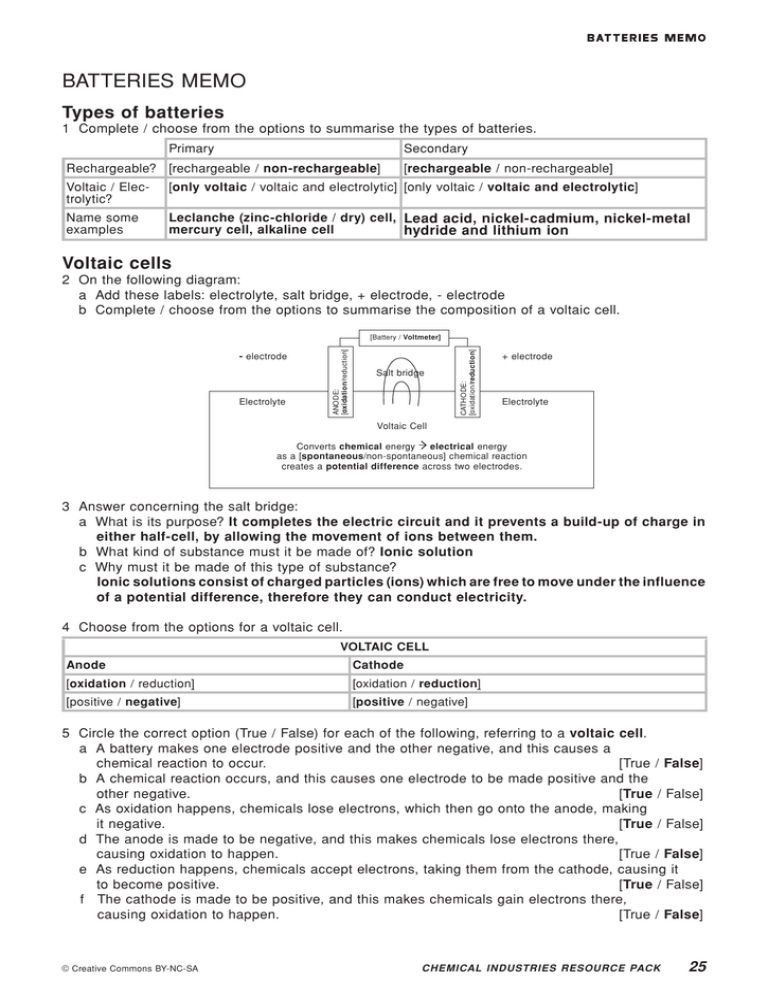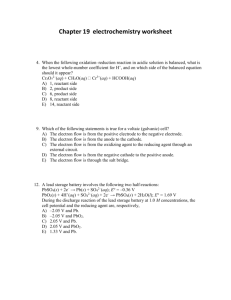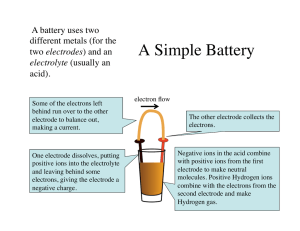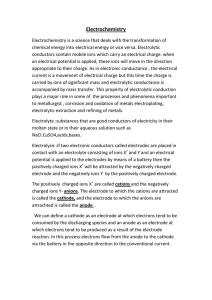Memo - Vula
advertisement

BATTERIES MEMO Types of batteries 1 Complete / choose from the options to summarise the types of batteries. Primary Secondary Rechargeable? [rechargeable / non-rechargeable] [rechargeable / non-rechargeable] Voltaic / Electrolytic? [only voltaic / voltaic and electrolytic] [only voltaic / voltaic and electrolytic] Name some examples Leclanche (zinc-chloride / dry) cell, Lead acid, nickel-cadmium, nickel-metal mercury cell, alkaline cell hydride and lithium ion Voltaic cells 2 On the following diagram: a Add these labels: electrolyte, salt bridge, + electrode, - electrode b Complete / choose from the options to summarise the composition of a voltaic cell. Electrolyte Salt bridge CATHODE: [oxidation/reduction] - electrode ANODE: [oxidation/reduction] [Battery / Voltmeter] + electrode Electrolyte Voltaic Cell Converts chemical energy electrical energy as a [spontaneous/non-spontaneous] chemical reaction creates a potential difference across two electrodes. 3 Answer concerning the salt bridge: a What is its purpose? It completes the electric circuit and it prevents a build-up of charge in either half-cell, by allowing the movement of ions between them. b What kind of substance must it be made of? Ionic solution c Why must it be made of this type of substance? Ionic solutions consist of charged particles (ions) which are free to move under the influence of a potential difference, therefore they can conduct electricity. 4 Choose from the options for a voltaic cell. VOLTAIC CELL Anode Cathode [oxidation / reduction] [oxidation / reduction] [positive / negative] [positive / negative] 5 Circle the correct option (True / False) for each of the following, referring to a voltaic cell. a A battery makes one electrode positive and the other negative, and this causes a chemical reaction to occur. [True / False] b A chemical reaction occurs, and this causes one electrode to be made positive and the other negative. [True / False] c As oxidation happens, chemicals lose electrons, which then go onto the anode, making it negative. [True / False] d The anode is made to be negative, and this makes chemicals lose electrons there, causing oxidation to happen. [True / False] e As reduction happens, chemicals accept electrons, taking them from the cathode, causing it to become positive. [True / False] f The cathode is made to be positive, and this makes chemicals gain electrons there, causing oxidation to happen. [True / False] Creative Commons BY-NC-SA CHEMICAL INDUSTRIES RESOURCE PACK Lead acid battery (Car battery) Overview 6 A lead acid battery consists of [primary/secondary] cells. 7 Complete / choose from the options. Discharging Charging [electrolytic / voltaic] cells [electrolytic / voltaic] cells [produces / requires] electrical energy [produces / requires] electrical energy [spontaneous / non-spontaneous] [spontaneous / non-spontaneous] [exothermic / endothermic] [exothermic / endothermic] Energy conversion chemical energy electrical energy Anode [Pb / PbO2] Chemical reaction Oxidation reaction Pb Cathode electrical energy [Pb / PbO2] PbSO4 + 2H2O Pb2+ + 2e - [Pb / PbO2] PbO2 + Pb + 4H+ + 2SO42- PbO2 + 4H+ + SO42- + 2e - [Pb / PbO2] + 2Reduction reaction PbO2 + 4H + SO4 + 2e PbSO4 +2H2O Net redox reaction chemical energy 2PbSO4+ 2H2O Pb2+ + 2e - Pb 2PbSO4 + 2H2O PbO2 + Pb + 4H+ + 2SO42- Discharging 8 Complete the explanation by filling the gaps or choosing from the options. Do this before, or after, but not during, watching the animations. Mark during re-watching. Overview When the lead acid battery is discharging it behaves as a set of [electrolytic/ voltaic] cells. Each lead acid battery consists of six cells. Only one of these is shown here. Each cell converts chemical energy into electrical energy, as a [spontaneous/non-spontaneous] chemical reaction [requires/creates] a potential difference across two electrodes. A lead acid battery has one electrode made of lead dioxide and another of lead. These are inside a sulfuric acid electrolyte. Anode Lead atoms in the lead electrode are [oxidised/reduced]: they [gain/lose] two electrons each. This changes them into [positively/negatively/neutrally] charged lead [atoms/ions] of formula Pb2+. Since [oxidation/reduction] occurs at this electrode, we call it the anode. The Pb2+ ions move away from the electrode, leaving the electrons they had just lost behind on the electrode. This makes this electrode, the anode, [positively/negatively/neutrally] charged, creating a potential difference between it and the other electrode, which is positive relative to it. This causes electricity to flow between the two electrodes. Cathode Electrons move from the [lead/lead dioxide] anode to the [lead/lead dioxide] cathode. There the electrons are [accepted/released] by positively charged lead ions in the lead dioxide electrode. The lead ions here have a [4+/2+] charge. Each lead [4+/2+] ion accepts two electrons and is reduced to a lead [4+/2+] ion. [Oxidation/Reduction] occurs at this electrode. It is therefore called the [cathode/ anode]. Because electrons are removed from the electrode in this way, it is charged [negatively/ positively]. These lead ions combine with sulfate ions from the sulfuric acid electrolyte to form lead sulphate. Hydrogen ions from the sulfuric acid electrolyte combine with oxide ions from the lead dioxide electrode to form water. CHEMICAL INDUSTRIES RESOURCE PACK Creative Commons BY-NC-SA Overall reaction The overall reaction of the discharging lead acid battery is the reaction of lead and lead dioxide electrodes with sulfuric acid to form lead sulfate and water. This is a spontaneous, redox reaction which converts chemical into electric energy. • It is spontaneous because the reaction will occur on its own: you don't need to heat it or provide an external potential difference to force it to occur. • It is a redox reaction: it involves the transfer of electrons from one chemical to another. • It converts chemical into electrical energy as the chemical reaction creates a potential difference across the electrodes. Charging 9 Complete the explanation by filling the gaps or choosing from the options. Do this before, or after, but not during, watching the animations. Mark during re-watching. Overview When the lead acid battery is charging it behaves as a set of [electrolytic/voltaic] cells. It converts electrical energy into chemical energy as a [spontaneous/non-spontaneous] chemical reaction is forced to occur due to an external potential difference being placed across two electrodes. To charge a lead acid battery, the lead dioxide electrode must be connected to the [positive/negative] terminal of an external power source, e.g. another battery. The lead electrode must be connected to the [positive/negative] terminal of this other battery. This pulls electrons from the [lead/lead dioxide] electrode and forces electrons into the [lead/lead dioxide] electrode. This causes the reactions which had occurred in the discharging reaction to take place [in the same direction/in reverse]. Anode The battery pulls electrons out of the electrode connected to its [positive/negative] terminal. Because of this, electrons are pulled out of the Pb2+ ions in the lead sulfate around this electrode. This produces [Pb2+/Pb4+] ions. Because the [Pb2+/Pb4+] ions [gain/lose] electrons as they become Pb4+ ions, [oxidation/ reduction] is taking place. This electrode is therefore called the [anode/cathode]. Notice that in an electrolytic cell, such as this one, the anode is [positively/negatively] charged. This is opposite to the case of a voltaic cell. In an electrolytic cell the external power supply (e.g. battery) charges the anode positively, which forces oxidation to occur there. Cathode The external battery [pushes electrons into/pulls electrons out of] the electrode connected to its negative terminal, charging that electrode [positively/negatively]. This forces lead ions, of formula Pb2+, to accept two electrons each, changing them into lead atoms, of formula Pb. This is called [oxidation/reduction], since it involves the acceptance of electrons. Grey lead metal is formed through this reduction reaction. The electrode at which reduction happens is called the cathode. Therefore in an electrolytic cell, such as this one, the [positively/negatively] charged electrode is the cathode. Overall reaction The overall reaction of the charging lead acid battery is the reaction of lead ions in lead sulfate to form lead at the cathode and lead dioxide at the anode. This is a non-spontaneous redox reaction which converts electrical into chemical energy. • It is non-spontaneous because the reaction will not occur on its own: you need to heat it or provide an external potential difference to force it to occur. • It is a redox reaction: it involves the transfer of electrons from one chemical to another. • It converts electrical into chemical energy as a potential difference forces a non-spontaneous chemical reaction to occur. Creative Commons BY-NC-SA CHEMICAL INDUSTRIES RESOURCE PACK





